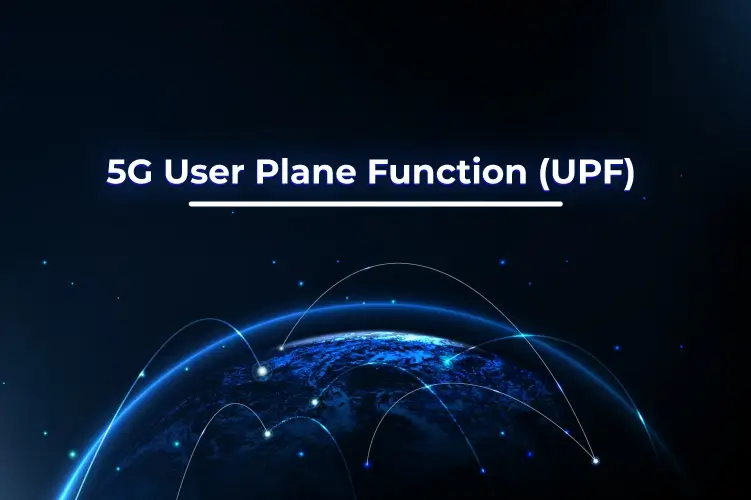What is the 5G User Plane Function (UPF)? | An Overview
5G User Plane Function (UPF) – An Overview
5G is rewriting the rules of connectivity, bringing about sweeping transformation not just in the telecommunications landscape but across industries. Along with enhancing mobile broadband experiences, it also supports and accelerates innovation in domains like AI ML, AR VR, automotive, energy, and healthcare, among many others. 5G’s promise to enable use cases across verticals with diverse performance requirements lays down demanding and challenging throughput, latency, and reliability requirements for a better experience. 5G User Plane Function (UPF), the primary conduit in processing all network data, plays a crucial role in the 5G network’s ability to realize the vision of being ultra-reliable and supporting low latency and high throughput.
5G UPF – Prime Enabler of New 5G Applications & Customer-Specific Edge Services
The UPF is one of the central elements of a 3GPP 5G core system architecture. It is a primary network function (NF) of the 5G core network (5GC) and plays the most critical role in data transfer. It interconnects the Data Network (DN) in the 5G architecture. It is also responsible for packet routing and forwarding, packet inspections, QoS (Quality of Service) handling, and an anchor point for intra & inter RAT mobility, with new functions on the horizon.
UPF is a Virtual Network Function (VNF) that offers a high-performance forwarding engine for user traffic. It uses Vector Packet Processing (VPP) technology to achieve ultra-fast packet forwarding while retaining compatibility with all the user plane functionality. This allows packet processing and traffic aggregation to be performed closer to the network edge, making UPF the prime enabler of new 5G applications and customer-specific edge services.
UPF Architecture
UPF is at the heart of the data plane evolution of a Control, and User Plane Separation (CUPS) strategy, a central component of the 3GPP 5G core networks. In 5G, the control and user planes are split (CUPS) and deployed in a new service-based architecture (SBA). The primary goal of CUPS is to support 5G New Radio (NR) implementation enabling early IoT applications and higher data rates. CUPS for Evolved Packet Core (EPC) functions allow operators to gain increased control over the data packets management in the network and provide additional services at the network edge. This gives the flexibility to deliver user plane functionality at the edge and the network core, allowing the UPF to be co-located with local and central data centers.
Along with serving as a full-on IP router, the UPF also routes traffic to mobile devices as they move between base stations. It also enforces QoS protocols, accounts for subscriber usage, and moderates traffic for idle devices, providing a packet processing foundation for the new generation of Service Based Architectures (SBAs). Additionally, it must execute all these features at ever-growing speeds for a rapidly increasing number of mobile devices.
Furthermore, to meet the 5Gs fundamental mandate for granular capacity or application-driven instantiation and up/downscaling, the UPF must be implemented as a cloud-native network function using modern microservices methodologies and deployable within a serverless framework. It must be highly automated and orchestrated to enhance data plane acceleration, user-space, and runtime programmability techniques and seamlessly integrate with cloud orchestration systems like Kubernetes.
The UPF has four distinct reference points
- N3: Interface between RAN (gNodeB) and the (initial) UPF
- N9: Interface between two UPFs (intermediate I-UPF & UPF Session Anchor)
- N6: Interface between Data Network (DN) and UPF
- N4: Interface between Session Management Function (SMF) & the UPF
Pivotal functions of UPF
A single instance of 5G UPF is responsible for providing some or all of the following under extreme throughput conditions. It also must be 100% stable to meet 5G’s ultra-reliable connectivity requirements.
- External Protocol Data Unit (PDU) session point interconnect with Data Network
- Anchor point for Intra-RAT and Inter-RAT mobility (where applicable)
- Packet routing and data forwarding
- QoS management for User Plane
- Traffic usage reporting
- Uplink Traffic Verification
- Transport level packet marking in Uplink and Downlink
- Downlink packet buffering and triggering Downlink Data Notification
Final Thoughts
With the onset of commercial deployments, network operators increasingly face the challenge of providing a fast, latency-sensitive, and cost-effective gateway between the edge and the data network to keep up with the rapidly increasing network traffic. The need of the hour is a modular, extensible, service-based, scalable solution optimized to meet the higher performance requirements of the 5G ecosystem. These critical differentiators drive the move to a more dense and faster 5G UPF architecture.
Amantya’s 5G SA User Plane Function
Amantya’s standards-compliant 5G Standalone (SA) UPF is a cloud-native and highly optimized solution with powerful and intelligent packet processing capabilities, enabling mobility within and between Radio Access Technologies (RATs). It streamlines the critical function of processing subscriber traffic between RAN (Radio Access Network) and the DN (Data Network). A service-based and flexible solution with configurable and scalable hardware offloading capabilities and automation for edge deployments, Amantya’s UPF is optimized to meet the higher performance requirements of 5G networks. It supports the Quality of Service (QoS) and Quality of Experience (QoE) requirements of 5G, including low latency, dense connectivity, high bandwidth, and multi-tenancy, ensuring higher throughput and improved latency. Amantya’s UPF enables an easy to configure, future-ready, and adaptable data path that is highly responsive to a service provider’s unique demands and evolves with the dynamic architectural requirements of the telecommunications landscape.
|
Key features of Amantya’s User Plane Function
|
Do get in touch at connect@amantyatech.com if you want to know more about our 5G SA UPF & 5GC solution and how it can help scale your business. Our team would be happy to assist you.
